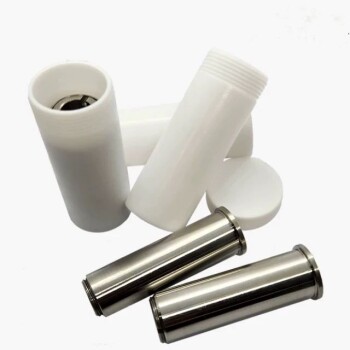Wiped film distillation (WFD) is a specialized distillation technique used to separate and purify heat-sensitive and highly viscous liquids. It involves creating a thin film of the liquid on a heated surface using rotating wipers, which enhances heat transfer and separation efficiency. The process is characterized by reduced exposure to high temperatures, making it ideal for preserving the quality of sensitive compounds. WFD is widely used in industries for devolatilization, purification, and stripping of raw liquids. It operates in either batch or continuous mode, offering high productivity, customization, and the ability to handle large-scale production. The final product is of high quality, often requiring two passes through the system for optimal results.
Key Points Explained:

-
Definition and Purpose of Wiped Film Distillation:
- Wiped film distillation is a vertical distillation process designed for heat-sensitive and viscous liquids.
- It separates compounds by creating a thin film of the liquid on a heated surface, allowing efficient heat transfer and evaporation of lighter fractions.
- The process is commonly used for devolatilization, purification, and removing unwanted compounds from raw liquids.
-
How Wiped Film Distillation Works:
- Feed Introduction: Crude oil or feed material is pumped into a vertical cylindrical evaporator using an automatic dosing pump.
- Thin Film Creation: Specially designed wipers (e.g., PTFE rollers) rotate and spread the liquid into a thin film (0.1 to 0.5 mm thick) on the inner wall of the evaporator.
- Heat Transfer: The heated outer wall of the evaporator conducts heat to the thin film, causing lighter fractions to vaporize.
- Vapor Condensation: The vaporized components travel to an internal or external condenser, where they condense into a liquid.
- Separation of Components: Heavier residues continue downward and are collected separately from the distillate.
-
Key Components of the System:
- Vertical Cylindrical Evaporator: The main chamber where the thin film is created and heated.
- Rotating Wipers: Distribute the liquid into a thin, turbulent film for efficient heat transfer.
- Condenser: Cools the vaporized components, turning them back into a liquid.
- Receiving Vessels: Collect the high-temperature residue and distillate separately.
- Temperature and Vacuum Control: Ensures optimal conditions for separation and preservation of sensitive compounds.
-
Benefits of Wiped Film Distillation:
- Reduced Exposure to Heat: The thin film minimizes the time the liquid is exposed to high temperatures, preserving the quality of heat-sensitive components.
- High Productivity: Continuous operation mode increases throughput and efficiency.
- Customization: The system can be tailored to specific industrial needs.
- Efficient Heat Transfer: Works effectively regardless of the liquid’s viscosity.
- High-Quality Distillate: Produces a pure and high-quality end product, often requiring two passes for optimal results.
-
Applications of Wiped Film Distillation:
- Pharmaceuticals: Purification of heat-sensitive compounds.
- Essential Oils: Separation and preservation of volatile terpenes.
- Petrochemicals: Devolatilization and purification of viscous raw materials.
- Food and Beverage: Processing of heat-sensitive extracts and flavors.
-
Operational Modes:
- Batch Mode: Suitable for smaller-scale operations or when processing specific batches of material.
- Continuous Mode: Ideal for large-scale production, offering increased productivity and efficiency.
-
Optimization of the Process:
- Temperature Control: Precise regulation of the feed container and outer jacketed wiped film body using recirculating heaters.
- Vacuum Control: Maintains low pressure to reduce boiling points and prevent thermal degradation.
- Feed Rate Optimization: Ensures consistent and efficient processing of the liquid.
-
Advantages Over Traditional Distillation:
- Preservation of Sensitive Compounds: Reduced thermal exposure maintains the integrity of heat-sensitive materials.
- Scalability: Suitable for both small-scale and large-scale production.
- Versatility: Can handle a wide range of viscosities and materials.
-
Challenges and Considerations:
- Complex Setup: Requires careful optimization of temperature, vacuum, and feed rate.
- Initial Investment: Higher cost compared to traditional distillation methods.
- Maintenance: Regular upkeep of wipers and other components is necessary for consistent performance.
-
Future Trends:
- Automation: Increasing use of automated systems for precise control and monitoring.
- Sustainability: Development of energy-efficient designs and integration with renewable energy sources.
- Customization: Growing demand for tailored solutions to meet specific industrial requirements.
In summary, wiped film distillation is a highly efficient and versatile method for separating and purifying heat-sensitive and viscous liquids. Its ability to minimize thermal exposure, combined with high productivity and customization options, makes it a preferred choice in various industries. However, it requires careful optimization and maintenance to achieve optimal results.
Summary Table:
| Aspect | Details |
|---|---|
| Process | Vertical distillation with rotating wipers creating a thin liquid film. |
| Key Benefits | Reduced heat exposure, high productivity, customization, efficient transfer. |
| Applications | Pharmaceuticals, essential oils, petrochemicals, food and beverage. |
| Operational Modes | Batch or continuous mode for scalable production. |
| Key Components | Evaporator, rotating wipers, condenser, receiving vessels, control systems. |
| Challenges | Complex setup, higher initial cost, regular maintenance required. |
Learn how wiped film distillation can optimize your process—contact us today for expert advice!











